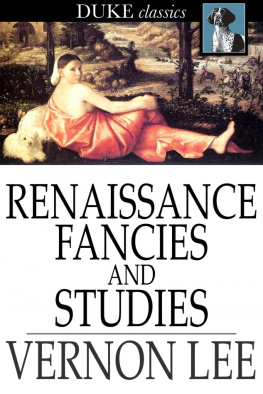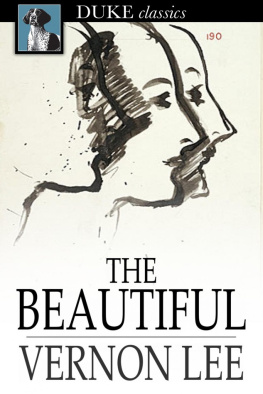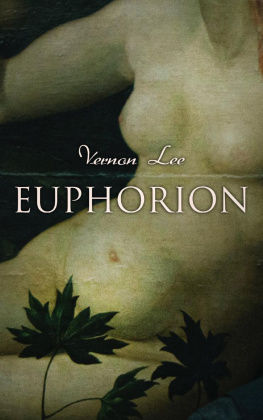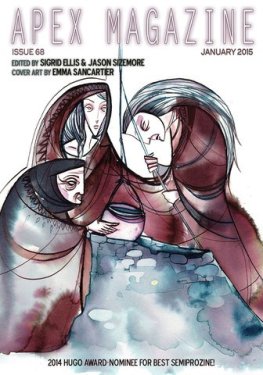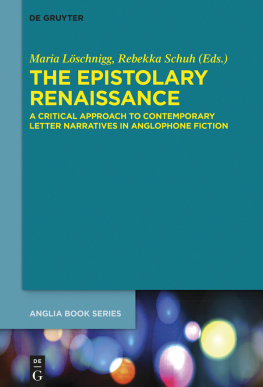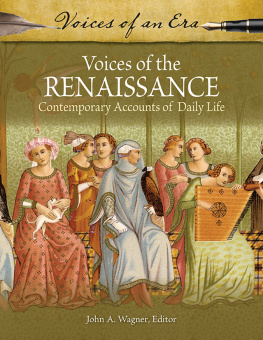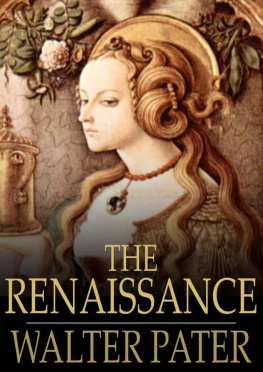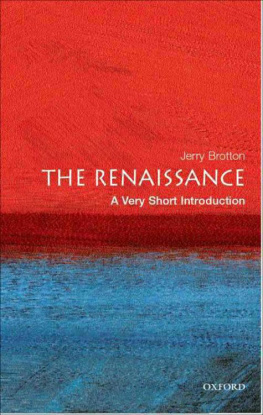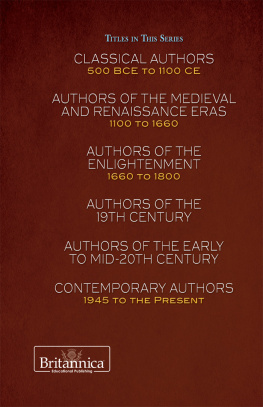RENAISSANCE FANCIES AND STUDIES
BEING A SEQUEL TO EUPHORION
* * *
VERNON LEE
*
Renaissance Fancies and Studies
Being a Sequel to Euphorion
First published in 1895
ISBN 978-1-63421-163-5
Duke Classics
2014 Duke Classics and its licensors. All rights reserved.
While every effort has been used to ensure the accuracy and reliability of the information contained in this edition, Duke Classics does not assume liability or responsibility for any errors or omissions in this book. Duke Classics does not accept responsibility for loss suffered as a result of reliance upon the accuracy or currency of information contained in this book.
Contents
*
*
TO
MY DEAR FRIENDSMARIA AND PIER DESIDERIO PASOLINI
EASTER 1895
Preface
*
These essays being mainly the outcome of direct personal impressions ofcertain works of art and literature, and of the places in which theywere produced, I have but few acknowledgments to make to the authors ofbooks treating of the same subject. Among the exceptions to this rule, Imust mention foremost Professor Tocco's Eresia nel Medio Evo, MonsieurGebhart's Italie Mystique, and Monsieur Paul Sabatier's St. Franoisd'Assise.
I am, on the other hand, very deeply indebted to the conversation andadvice of certain among my friends, for furnishing me second-hand alittle of that archological and critical knowledge which is now-a-daysquite unattainable save by highly trained specialists. My best thanks,therefore, to Miss Eugnie Sellers, editor of Furtwngler's "Masterpiecesof Greek Sculpture;" to Mr. Bernhard Berenson, author of "VenetianPainters," and a monograph on Lorenzo Lotto; and particularly to myfriend Mrs. Mary Logan, whose learned catalogue of the Italian paintingsat Hampton Court is sufficient warrant for the correctness of myart-historical statements, which she has had the kindness to revise.
MAIANO, NEAR FLORENCE,
April 1895.
The Love of the Saints
*
I
*
"Panis Angelicus fit panis hominum. O res mirabilis, manducat DominumPauper, Servus et Humilis." These words of the Matins of the Most HolySacrament I heard for the first time many years ago, to the beautifuland inappropriate music of Cherubini. They struck me at that time asfoolish, barbarous, and almost gross; but since then I have learned tothink of them, and in a measure to feel of them, as of something greaterand more solemn than all the music that Cherubini ever wrote.
All the hymns of the same date are, indeed, things to think upon. Theyaffect onethe "Stabat Mater," for instance, and the "Ave Verum"verymuch in the same way as the figures which stare down, dingy green andblue, from the gold of the Cosmati's mosaics: childish, dreary, allstiff and agape, but so solemn and pathetic, and full of the greatestfuture. For out of those Cosmati mosaics, and those barbarous frescoesof the old basilicas, will come Giotto and all the Renaissance; and outof those Church songs will come Dante; they are all signs, poor primitiverhymes and primitive figures, that the world is teeming again, and willbear, for centuries to come, new spiritual wonders. Hence the importance,the venerableness of all those medival hymns. But of none so much, tomy mind, as of those words I have quoted from the Matins of the MostHoly Sacrament
"O res mirabilis, manducat Dominum,
Pauper, Servus et Humilis."
For their crude and pathetic literality, their image of the Godheadactually giving Himself, as they emphatically say, to be chewed by thepoor and humble man and the serf, show them to have been most especiallyborn, abortions though they be, in the mightiest throes of mysticalfeeling, after the incubation of whole nations, born of the great medivalmarriage, sublime, grotesque, morbid, yet health-bringing, betweenabstract idealising religious thought and the earthly affections oflovers and parentsa strange marriage, like that of St. Francis andPoverty, of which the modern soul also had to be born anew.
Indeed, if we realise in the least what this hymn must have meant,shouted in the processions of Flagellants, chaunted in the Pacts ofPeace after internecine town wars; above all, perhaps, muttered inthe cell of the friar, in the den of the weaver; if we sum up, howeverinadequately, the state of things whence it arose, and whence it helpedto deliver us, we may think that the greatest music is scarcely reverentenough to accompany these poor blundering rhymes.
The Feast of the Most Holy Sacrament, to whose liturgy this hymn, "O ResMirabilis," belongs, was instituted to commemorate the miracle of Bolsena,which, coming late as it did, in the country of St. Francis, and withintwo years of the birth of Dante, seems in its significant coincidences,in its startling symbolism, the fit material summing up of what isconveniently designated as the Franciscan revival: the introduction intoreligious matters of passionate human emotion. For in the year 1263, atBolsena in Umbria, the consecrated wafer dropped blood upon the hands ofan unbelieving priest.
This trickery of a single individual, or more probably hallucinationthislie and self-delusion of interested or foolish bystandersjust happenedto symbolise a very great reality. For during the earlier Middle Ages,before the coming of Francis of Assisi, the souls of men, or, moreproperly, their hearts, had been sorely troubled and jeopardised.
The mixture of races and civilisations, southern and northern andeastern, antique and barbarian, which had been slowly taking place eversince the fall of the Roman Empire, had seemed, in its consummation ofthe twelfth century, less fertile on the whole than poisonous. The oldtribal system, the old civic system, triumphant centralising imperialism,had all been broken up long since; and now feudalism was going to piecesin its turn, leaving a chaos of filibustering princelets, among whomloomed the equivocal figures of Provenal counts, of Angevin and Swabiankings, brutal as men of the North, and lax as men of the South; moreover,suspiciously oriental; brilliant and cynical persons, eventually to betypified in Frederick II., who was judiciously suspected of beingAntichrist in person. In the midst of this anarchy, over-rapid industrialdevelopment had moreover begotten the tendencies to promiscuity, tomystical communism, always expressive of deep popular misery. The HolyLand had become a freebooter's Eldorado; the defenders of Christ'ssepulchre were turned half-Saracen, infected with unclean mixtures ofcreeds. Theology was divided between neo-Aristotelean logic, abstractand arid, and Alexandrian esoteric mysticism, quietistic, nay, nihilistic;and the Church had ceased to answer to any spiritual wants of the people.Meanwhile, on all sides everywhere, heresies were teeming, austere andequivocal, pure and unclean according to individuals, but all of themanarchical, and therefore destructive at a moment when, above all, orderand discipline were wanted. The belief in the world's end, in the speedycoming of Antichrist and the Messiah, was rife among all sects; andlearned men, the disciples of Joachim of Flora, were busy calculatingthe very year and month. Lombardy, and most probably the south of France,Flanders and the Rhine towns, were full of strange Manichean theosophies,pessimistic dualism of God and devil, in which God always got the worstof it, when God did not happen to be the devil himself. The raveninglions, the clawing, tearing griffins, the nightmare brood carved on thecapitals, porches, and pulpits of pre-Franciscan churches, are surelynot, as orthodox antiquarians assure us, mere fanciful symbols of theChurch's vigilance and virtues: they express too well the far-spreadoccult Manichean spirit, the belief in a triumphant power of evil.

